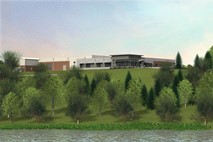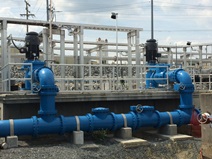Over the months leading to our annual Design-Build Conference & Expo, hosted this year in Denver Colorado from November 2-4, we will be posting weekly projects that have earned the distinction as a 2015 DBIA Merit Award winner. These projects, at a minimum, resulted in highly successful delivery and achieved best value while meeting design and construction quality, cost and schedule goals. These projects will also be highlighted during the Design-Build Conference & Expo on November 3 during an Awards Reception. Please join us by registering for the conference here. This week we recognize the winners from our Water/Wastewater Category.
 Lawton Valley and Station No. 1 Water Treatment Plants Design-Build
Lawton Valley and Station No. 1 Water Treatment Plants Design-Build
Challenge Design-Build Project Delivery Addressed:
On this project, both sites had elevated levels of arsenic in soils. The joint-venture (JV) conducted comprehensive sampling and soil characterization to define the limit and extent of the contamination. Working as a joint-venture, there was constant feedback during the design to ensure that the proposed solutions were in line with the proposed cost. By keeping regulatory stakeholders abreast of the project schedules and obtaining early buy-in, a good relationship was fostered. To address the soil problem, the JV continued to work closely with the regulators to define a disposal protocol. Finally, the JV managed the soil disposal and completed a closeout plan.
Summary:
As a resort community, Newport, Rhode Island, is faced with higher water demands during the summer when raw water quality is at its poorest. In addition, increased drinking water quality regulations and water treatment plant capacity and reliability issues prompted the City to seek a new solution that best serves local residents and businesses. The Newport Water System is a regional system providing public drinking water to three communities, both retail and wholesale. To meet a looming Consent Order date and to achieve the goals of quality, cost, schedule and risk, the City decided to use design-build for the water system improvements. The heart of the project was the replacement of an aging water treatment plant (WTP) at Lawton Valley and the upgrade of a second location, the Station No. 1 WTP located in Newport. The Station No. 1 WTP was 25 years old and was in need of significant upgrades. Finished water production at the upgraded plant is 9 million gallons per day and the improvements include a new rapid mix, coagulation chamber, retrofit of the existing sludge blanket clarifier tanks with a new high-rate Dissolved Air Flotation (DAF) System, new chemical feed equipment, laboratory improvements and post-filter absorbers using granular activated carbon.
 McAlpine Creek WWMF Design-Build Effluent Filters Upgrades and Expansion
McAlpine Creek WWMF Design-Build Effluent Filters Upgrades and Expansion
Challenge Design-Build Project Delivery Addressed:
The owner desired to have greater control by being an involved and integral part of the design-build team through collaboration, communication and development of technical solutions. Throughout the development of the Guaranteed Maximum Price (GMP), the owner wanted to add scope to the project, and of course each item added cost. Increased collaboration through the design-build process allowed the contractor to present each item in an a la carte list so the owner could decide what was critical and what could be cut. Using the strategy of open collaboration, the project was completed under the GMP allowing the owner to receive additional scope items. In short, all parties were partners on this project and challenges and issues were dealt with as partners.
Summary:
The McAlpine Creek Wastewater Management Facilities is located just outside Charlotte, North Carolina. It is the largest of all Charlotte-Mecklenburg Utilities Department (CMUD) Wastewater Management Facilities with a daily treatment capacity of 64 million gallons per day (MGD). The Charlotte area has experienced steady residential and commercial growth for several years and gained valuable rewards as a result; however, along with the rewards that growth generates, additional strain on the infrastructure was created. Crowder Construction Company, along with team member HDR Engineering, was selected as the design-build team to design and construct an effluent filter structure enabling the facility to increase its rated capacity to 80 MGD. The scope of work included design and construction of nine new filter bays tied into existing filters, water control gates, pumped water for filter backwash, forebay improvements, modifications to manholes, chemical treatment addition, slope stabilization, storm water improvements, site work and a new packaged electrical house for the filters. CMUD elected to pursue an alternative delivery process (ADP) for the filter improvements.
 Oakley Station CSO 551 & 553 Separation Sewer Project
Oakley Station CSO 551 & 553 Separation Sewer Project
Challenge Design-Build Project Delivery Addressed:
The owner required expedited project delivery to exploit a small window of opportunity to cost effectively satisfy a future consent decree requirement. Although the design phase tested the project team, the most difficult challenges were encountered and overcome with innovative solutions during the construction phase. Most of the necessary permitting agencies were not set-up to release permits for design-build type projects. The project team had identified this issue early in the risk register and took steps necessary to mitigate the impact on the project schedule. Once the permits were issued and the work commenced, multiple underground conflicts were encountered such as existing foundations buried under the roads, buried large diameter water main gate valves, and active telephone ducts banks that were previously reported as abandoned by the service provider. The costs for these changes were expeditiously mitigated through teamwork and trust. Equitable schedule adjustments were made for the unusually harsh, early winter conditions experienced at the end of the project. The team’s weekly meetings, close coordination, and flexibility allowed the project to be completed on time and without impact to the critical economic development.
Summary:
The City of Cincinnati, Ohio, is a vibrant and thriving community with a progressive mentality. Economic development within the City was underway to revitalize a long-abandoned and polluted industrial area. The Metropolitan Sewer District of Greater Cincinnati (MSDGC) envisioned an opportunity to separate storm and sanitary flows within the drainage basin of the area being revitalized in order to remedy certain combined sewer overflow (CSO) Consent Decree requirements. MSDGC leadership had been longtime advocates for collaborative project delivery systems and actually played a vital role in lobbying the State of Ohio for recently enacted construction reform laws. MSDGC leadership commenced with internal educational programs regarding the advantages of design-build and in short order accomplished the necessary organizational culture shift. The project not only succeeded, it surpassed all expectations by every measure in terms of solution optimization, collaboration, flexibility, risk allocation/sharing, quality, delivery time, cost savings, impact to stakeholders, partnering and teamwork. MSDGC received value above and beyond the face value of the design-build contract through cost avoidance and shared incentives which resulted in significant savings for the project. The costs associated with the differing site conditions encountered were amicably absorbed before the savings that resulted from the design review process were split between the owner and the design-builder.
